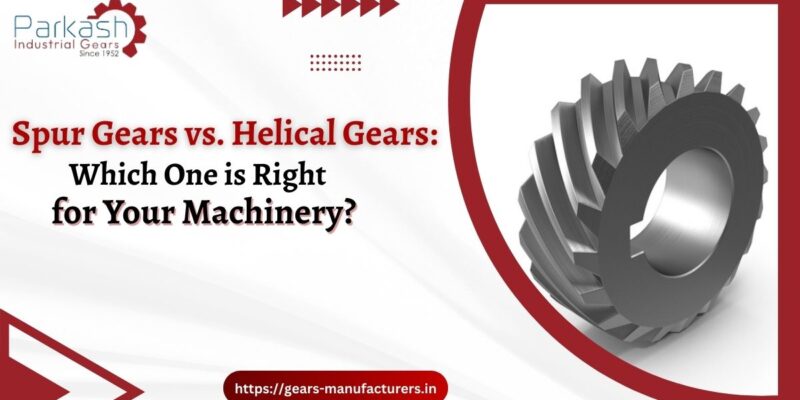
Spur Gears vs. Helical Gears: Which One is Right for Your Machinery?
The selection between spur and helical gears when picking the appropriate gears for industrial machinery has a big influence on lifespan, performance, and efficiency. Engineers and owners of machinery may make an educated decision by being aware of the distinct benefits and drawbacks of each type of gear. The distinctions between spur and helical gears, their uses, and how to choose the best one for your particular equipment needs will all be covered in this blog.
Knowing About Helical Gears
Helical gears are characterized by sloping teeth that are diagonal to the gear face. As a result, there is gradual engagement, which makes the gears run more smoothly and quietly.
Helical Gear Manufacturer
When it comes to industrial machinery, selecting the right helical gear manufacturer is essential for ensuring long-term efficiency and performance. These manufacturers specialize in crafting gears with angled teeth that operate more quietly and smoothly than standard designs. A skilled helical gear manufacturer understands the importance of material strength, accurate machining, and reliable gear alignment. Many industries, from automotive to heavy engineering, rely on a trusted helical gear manufacturer to deliver gears capable of withstanding continuous use. Working with an experienced helical gear manufacturer not only improves operational output but also reduces noise and minimizes the risk of mechanical failure.
Key Characteristics of Helical Gears
-
Silent Operation: Sloping teeth create a smoother and quieter meshing than spur gears.
-
Increased Weight Carrying Capacity: They are ideal for applications requiring high weight carrying because they distribute the load more evenly.
-
Longevity: Less wear and tear owing to progressive tooth engagement.
-
Axial Thrust: Creates side thrust that needs to be addressed in the system.
-
Applications: Found in automotive transmissions, elevators, heavy equipment, and industrial power drives.
Numerous helical gear manufacturer boast of their higher performance in tough environments where precision and quiet operation are needed.
Knowing Spur Gears
The most basic and widely used kind of gear in mechanical operations is the spur gear. Spur gears are very easy to design and manufacture, with straight teeth mounted on a parallel shaft.
Main Features of Spur Gears:
-
Efficiency: Spur gears are highly efficient because there is very little slippage and direct contact of teeth.
-
Cost-Effective: Production and maintenance expenses are usually low.
-
Noise Level: They make more noise, especially when moving quickly.
-
Load Capacity: Suitable for applications with modest loads.
-
Applications: Widely utilized in gear pumps, conveyors, washing machines, and simple industrial equipment.
Spur gear manufacturers typically recommend these gears for uses where affordability and ease of use are more important than smoothness and noise reduction.
Comparing Spur and Helical Gears
To help you decide which kind of equipment is best for your application, here is a side-by-side comparison:
| Feature | Spur Gears | Helical Gears |
|---|---|---|
| Tooth Design | Straight | Angled |
| Noise Level | Higher | Lower |
| Load Capacity | Moderate | High |
| Efficiency | High | Slightly lower due to sliding |
| Manufacturing Cost | Lower | Higher |
| Axial Load | None | Present (thrust bearings needed) |
| Utilizing | Medium-to-light duties | Medium-to-heavy weight |
Choosing the Proper Gear for Your Equipment
The following considerations should be noted while choosing between spur and helical gears:
1. Load Requirements
For continuous load running heavy-duty machinery, helical gears are more appropriate owing to their high load-handling ability.
For light-duty, sporadic usage, spur gears are economical and effective.
2. Noise Sensitivity
In situations where noise levels need to be low—like office machinery or hospitals—helical gears are the best choice.
Where noise is not a significant factor in industrial environments, spur gears will suffice.
3. Budget and Cost Considerations
Where budget is the top priority, spur gears are a cheaper alternative with less intricate machining.
Over time, helical gears provide higher smoothness and durability despite being more expensive.
4. Layout and Space
Helical gears provide greater design possibilities since they may be utilized with both parallel and non-parallel shafts.
Spur gears need parallel shaft alignment, which may limit the flexibility of the design.
The Significance of Gear Quality
The key to lifespan and performance in any kind of equipment is manufacturing quality. The efficiency and dependability of gears are largely determined by the accuracy of tooth design, material selection, and heat treatment.
Leading gear manufacturing companies make investments in superior CNC machining and quality control to deliver products that satisfy the exacting specifications of modern machinery. It is crucial to consider a company’s business profile, customisation choices, and level of experience when choosing between spur and helical gear production.
Final Thoughts
In modern technology, spur and helical gears both have a place. Whether it’s load capacity, noise level, cost, or mechanical design, the best choice depends on your specific operating needs.
Parkash Industrial Gears provides finely produced spur and helical gears with an emphasis on quality and durability if you’re searching for a reliable partner in gear solutions. They have been in the business for decades and are still regarded as one of the trustworthy brands in the gear making sector.
Choosing the right equipment is important for increasing performance, reducing maintenance, and extending the life of your equipment, not only for mechanical fit.

 FSC India.
FSC India.
This Post Has 0 Comments